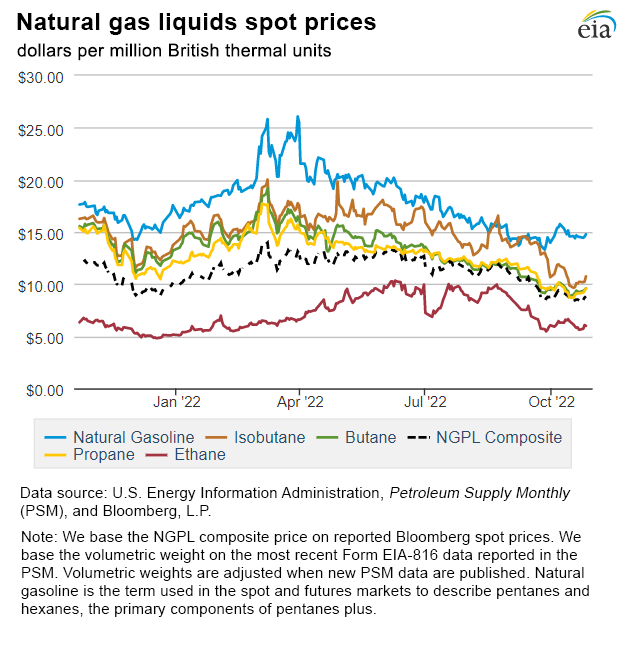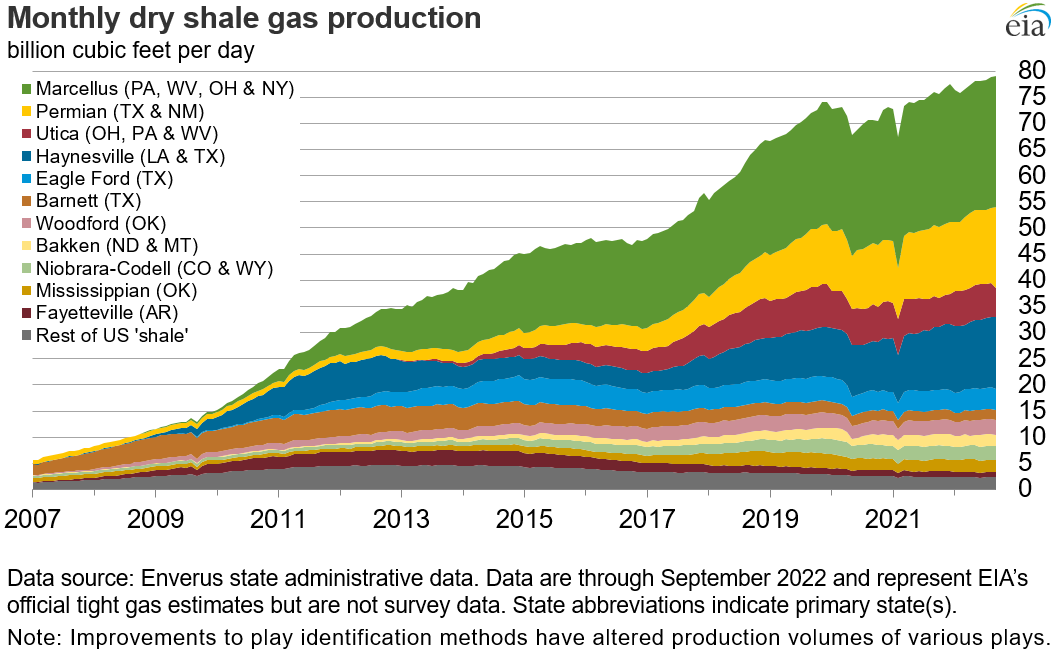In the News:
United States adds more combined-cycle natural gas turbine electric generating capacity in 2022
Eight new natural gas-fired combined-cycle gas turbine (CCGT) power plants have come online or will come online in the United States in 2022, adding 7,775 megawatts (MW) of electric generating capacity to the U.S. electric grid, based on EIA estimates and data from our latest Monthly Electric Generator Inventory. These additions will further solidify the position of CCGT plants as the single largest source of both electric generating capacity and electricity production. Natural gas consumption in the electric power sector averaged 31 billion cubic feet per day (Bcf/d) in 2021, or 37% of total U.S. natural gas consumption. We forecast natural gas consumption in the electric power sector will increase to almost 33 Bcf/d in 2022.
CCGT plants are one of four major sources of natural gas-fired power generation, and they are by far the largest in terms of capacity and electricity production. The differentiating feature of a CCGT plant is that it employs both a gas and a steam turbine. CCGT electric generating capacity is expected to reach almost 290 gigawatts (GW) by year-end, or 24% of the nation’s total generating capacity. As a result, output from the CCGT fleet will be positioned to rise from the 1,326,278 gigawatthours (GWh) it generated in 2021, which represented 32% of total electricity production that year. Shares of coal-fired (22%) and nuclear (19%) sources ranked second and third in electricity production in 2021.
The commissioning of 7,775 MW of new CCGT capacity in 2022 represents a rise in plant start-ups from the previous two years, when 5,002 MW and 3,578 MW were added in 2020 and 2021, respectively. However, gains this year are lower than those recorded from 2017 through 2019. Also, while year-over-year additions of new CCGT capacity steadily occurred over the past two decades, the 2022 total is about 80% below record capacity additions in 2002 and 2003. About half of the existing CCGT fleet currently operating came online between 2000 and 2006.
Another 4,215 MW of CCGT capacity will be added in 2023, when five new plants are slated to open. All of those facilities are under construction, with operations expected to begin before the end of the year.
Seven of the eight CCGT plants opening this year are located in either the upper Midwest or in Florida. The new plants are being built in these areas to meet rising demand for electricity and to replace retiring coal-fired electric generating plants.
In the PJM Interconnection region, three new CCGT plants are opening in 2022, totaling 3,918 MW of capacity. These additions will help replace 5,346 MW of coal-fired capacity in PJM that is retiring in 2022, followed by another 3,774 MW of coal capacity set to close in 2023. In Florida, the 2,222 MW of new CCGT capacity will replace 1,486 MW of coal-fired capacity that is retiring in 2022. In the Michigan portion of the MISO region, the retirement of 1,560 MW of existing coal-fired generating capacity in 2022 will be replaced by 1,403 MW of new CCGT capacity.
Market Highlights:
(For the week ending Wednesday, October 26, 2022)Prices
- Henry Hub spot price: The Henry Hub spot price fell 24 cents from $5.50 per million British thermal units (MMBtu) last Wednesday to $5.26/MMBtu yesterday.
- Henry Hub futures prices: The price of the November 2022 NYMEX contract increased 14.4 cents, from $5.462/MMBtu last Wednesday to $5.606/MMBtu yesterday. The price of the 12-month strip averaging November 2022 through October 2023 futures contracts climbed 12.2 cents to $5.302/MMBtu.
- Select regional spot prices: Natural gas spot prices fell at most locations this report week (Wednesday, October 20 to Wednesday, October 26). Week-over-week price declines at major pricing hubs ranged from $5.52/MMBtu at Waha Hub to $0.23/MMBtu at Chicago Citygate. Prices in the West were mixed. The price in Southern California at SoCal Citygate declined by $1.28/MMBtu, while price increases further north ranged from $1.05/MMBtu at Sumas and $1.37/MMBtu at Malin.
Prices in West Texas fell to negative levels this week. The price at the Waha Hub in West Texas, which is located near Permian Basin production activities, fell $5.52 this report week, from $4.87/MMBtu last Wednesday to -$0.65/MMBtu yesterday. The Waha Hub traded $5.91 below the Henry Hub price yesterday, compared with last Wednesday when it traded 63 cents below the Henry Hub price. Yesterday’s price is up from a weekly low of -$1.17/MMBtu on Tuesday, when the Waha Hub discount to Henry Hub was $6.37/MMBtu. The last time prices at the Waha Hub were negative was in October 2020, when the price fell to -$0.82/MMBtu on October 23. Production in West Texas, the Texas portion of the Permian Basin, increased 2%, or 0.2 billion cubic feet per day (Bcf/d), according to data from PointLogic. Consumption of natural gas in the Permian Basin decreased 12% (0.1 Bcf/d) from a week ago.
Pipeline maintenance in West Texas is contributing to the decline in prices, which is not unusual. Beginning, Tuesday, October 25, Kinder Morgan, operator of the Gulf Coast Express (GCX) pipeline, has been conducting inspections and repairs at the Rankin, Devils River, and Big Wells compressor stations. GCX delivers approximately 2 Bcf/d of natural gas from the Permian Basin to the Agua Dulce, Texas area. This maintenance has resulted in a reduction in pipeline capacity of approximately 700 million cubic feet per day (MMcf/d) to 900 MMcf/d. In addition, El Paso Natural Gas (EPNG) has several maintenance events this week, reducing natural gas flows out of the Permian Basin. Remediation on Line 1300 continues, which results in a reduction of about 300 MMcf/d of westbound pipeline capacity, and maintenance at the Plains compressor station in Yoakum County, Texas, is limiting northbound flows by more than 700 MMcf/d.
- Unlike most other pricing hubs, the price at Sumas on the Canada-Washington border rose $1.05 from $4.96/MMBtu last Wednesday to $6.01/MMBtu yesterday. The price at Malin, Oregon, the northern delivery point into the PG&E service territory, rose $1.37 from $5.02/MMBtu last Wednesday to $6.39/MMBtu yesterday. Concerned about low line pack levels on their pipeline systems, both Enbridge, operator of the Westcoast Energy system, and TC Energy, operator of Gas Transmission Northwest (GTN), have issued operational flow orders to maintain a minimum amount of natural gas flowing in their pipeline systems. Westcoast Energy, which delivers natural gas into the Northwest Pipeline at Huntington, British Columbia, across the border from Sumas, Washington, has had a system-wide operational flow order in effect since October 21. GTN, which receives natural gas produced in Canada at Kingsgate on the Idaho-British Columbia border and delivers natural gas into the Malin, Oregon, market, issued a low inventory operational flow order watch, effective October 26 through November 2. Although natural gas supply in the Pacific Northwest increased by 10% (0.3 Bcf/d) as a result of increased natural gas flows from the Rocky Mountains, natural gas consumption in all sectors in the Pacific Northwest rose 28% (0.5 Bcf/d) this report week. Temperatures in the Seattle City Area averaged 51°F this week, which resulted in 98 heating degree days (HDD), 76 more HDDs than last week.
- International futures prices: International natural gas futures prices declined this report week. According to Bloomberg Finance, L.P., weekly average futures prices for liquefied natural gas (LNG) cargoes in East Asia decreased $0.59 to a weekly average of $31.52/MMBtu, and natural gas futures for delivery at the Title Transfer Facility (TTF) in the Netherlands, the most liquid natural gas market in Europe, decreased $5.69 to a weekly average of $31.61/MMBtu. Earlier this report week, the TTF price dropped below the East Asia price for the first time since April of this year.
- Natural gas plant liquids prices: The natural gas plant liquids composite price at Mont Belvieu, Texas, remained flat at $8.60/MMBtu for the week ending October 26. The price of ethane fell 5%, while the natural gas price at the Houston Ship Channel fell 19%. The ethane premium to natural gas widened by 64%. The price of ethylene fell 3%, widening the ethylene to ethane premium by 2%. The natural gasoline price fell 1%. The propane price rose 4%, while the Brent crude oil price rose 1%, narrowing the propane discount to crude oil by 3%. The normal butane price and isobutane price both rose 3%.
Daily spot prices by region are available on the EIA website.
Supply and Demand
- Supply: According to data from PointLogic, the average total supply of natural gas fell by 0.1% (0.1 Bcf/d) compared with the previous report week. Dry natural gas production grew by 0.5% (0.5 Bcf/d) compared with the previous report week. Average net imports from Canada decreased by 9.9% (0.6 Bcf/d) from last week.
- Demand: Total U.S. consumption of natural gas fell by 7.8% (5.8 Bcf/d) compared with the previous report week, according to data from PointLogic. Temperatures in the Northeast and Midwest were warmer than normal this week and close to normal in much of the rest of the country. Natural gas consumed for power generation declined by 5.5% (1.7 Bcf/d) week over week. Industrial sector consumption decreased by 1.7% (0.4 Bcf/d), and consumption in the residential and commercial sectors declined by 18.4% (3.7 Bcf/d). Natural gas exports to Mexico decreased 4.5% (0.3 Bcf/d). Natural gas deliveries to U.S. LNG export facilities (LNG pipeline receipts) averaged 11.5 Bcf/d, or 0.1 Bcf/d higher than last week.
Liquefied Natural Gas (LNG)
- Pipeline receipts: Overall natural gas deliveries to U.S. LNG export terminals increased by 0.1 Bcf/d week over week to average 11.5 Bcf/d this report week. Natural gas deliveries to LNG export terminals in South Louisiana and South Texas contributed equally to this increase, averaging 8.7 Bcf/d and 2.4 Bcf/d, respectively, according to data from PointLogic. At the Cove Point terminal in Maryland, natural gas deliveries remained at 0 Bcf/d this week, as the terminal continues its annual planned maintenance that began on October 1.
- Vessels departing U.S. ports: Twenty-two LNG vessels (nine from Sabine Pass, five from Corpus Christi, four from Cameron, three from Calcasieu Pass, and one from Elba Island) with a combined LNG-carrying capacity of 81 Bcf departed the United States between October 20 and October 26, according to shipping data provided by Bloomberg Finance, L.P.
Rig Count
- According to Baker Hughes, for the week ending Tuesday, October 18, the natural gas rig count remained the same as a week ago at 157 rigs. The number of oil-directed rigs increased by 2 rigs from a week ago to 612 rigs. The DJ-Niobrara added three rigs and one rig was dropped in an unidentified producing region. The total rig count, which includes 2 miscellaneous rigs, now stands at 771 rigs, which is 229 more rigs than the same week last year.
Storage
- The net injections into storage totaled 52 Bcf for the week ending October 21, compared with the five-year (2017–2021) average net injections of 66 Bcf and last year's net injections of 88 Bcf during the same week. Working natural gas stocks totaled 3,394 Bcf, which is 197 Bcf (5%) lower than the five-year average and 142 Bcf (4%) lower than last year at this time.
- According to The Desk survey of natural gas analysts, estimates of the weekly net change to working natural gas stocks ranged from net injections of 49 Bcf to 73 Bcf, with a median estimate of 59 Bcf.
- The average rate of injections into storage is 4% higher than the five-year average so far in the refill season (April through October). If the rate of injections into storage matched the five-year average of 5.4 Bcf/d for the remainder of the refill season, the total inventory would be 3,448 Bcf on October 31, which is 197 Bcf lower than the five-year average of 3,645 Bcf for that time of year.
See also:
Top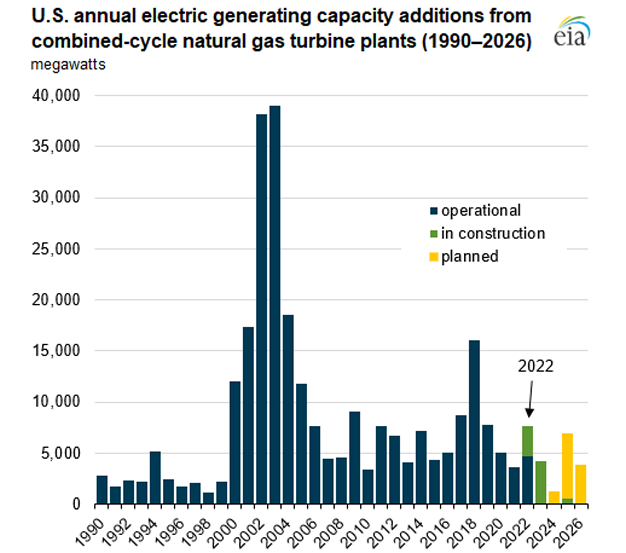
Data source: U.S. Energy Information Administration, Monthly Electric Generator Inventory
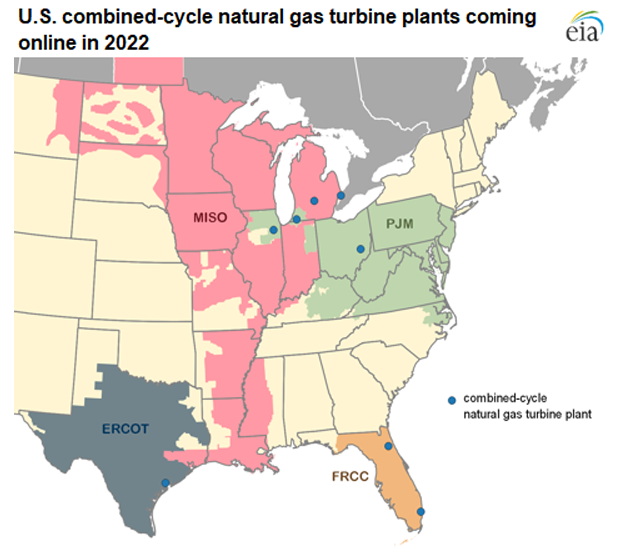
Data source: U.S. Energy Information Administration, Monthly Electric Generator Inventory, and Hitachi Energy - Velocity Suite
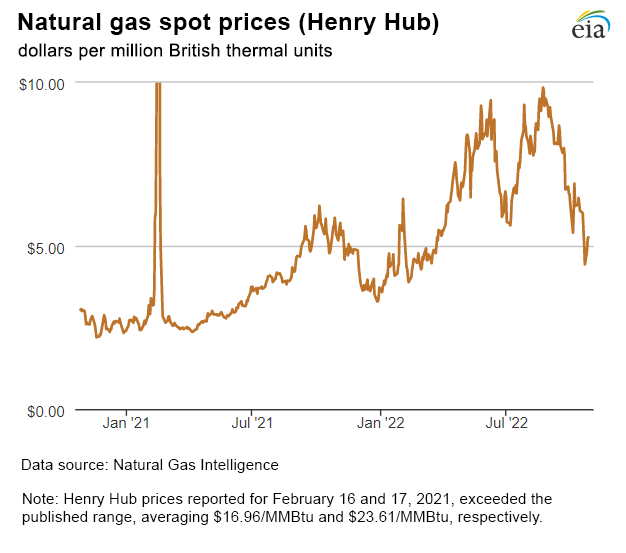
| Spot Prices ($/MMBtu) | Thu, 20-Oct |
Fri, 21-Oct |
Mon, 24-Oct |
Tue, 25-Oct |
Wed, 26-Oct |
|---|---|---|---|---|---|
| Henry Hub |
5.05 |
4.43 |
4.81 |
5.20 |
5.26 |
| New York |
4.40 |
3.31 |
3.96 |
4.25 |
4.44 |
| Chicago |
4.68 |
3.84 |
4.37 |
4.86 |
5.03 |
| Cal. Comp. Avg.* |
5.62 |
4.78 |
5.63 |
6.38 |
6.44 |
| Futures ($/MMBtu) | |||||
| November contract | 5.358 |
4.959 |
5.199 |
5.613 |
5.606 |
| December contract |
5.838 |
5.472 |
5.753 |
6.166 |
6.119 |
| Data source: Natural Gas Intelligence and CME Group as compiled by Bloomberg, L.P. *Avg. of NGI's reported prices for: Malin, PG&E Citygate, and Southern California Border Avg. |
|||||
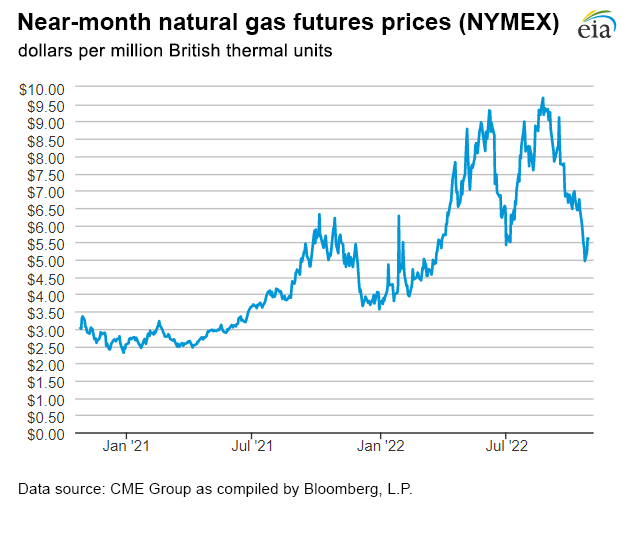
| U.S. natural gas supply - Gas Week: (10/20/22 - 10/26/22) | |||
|---|---|---|---|
Average daily values (billion cubic feet) |
|||
this week |
last week |
last year |
|
| Marketed production | 111.1 |
110.6 |
106.6 |
| Dry production | 99.1 |
98.6 |
96.5 |
| Net Canada imports | 5.2 |
5.8 |
5.7 |
| LNG pipeline deliveries | 0.1 |
0.1 |
0.1 |
| Total supply | 104.4 |
104.5 |
102.2 |
|
Data source: PointLogic | |||
| U.S. natural gas consumption - Gas Week: (10/20/22 - 10/26/22) | |||
|---|---|---|---|
Average daily values (billion cubic feet) |
|||
this week |
last week |
last year |
|
| U.S. consumption | 68.5 |
74.3 |
66.0 |
| Power | 29.3 |
31.0 |
29.3 |
| Industrial | 22.9 |
23.3 |
22.0 |
| Residential/commercial | 16.4 |
20.0 |
14.7 |
| Mexico exports | 5.8 |
6.1 |
6.1 |
| Pipeline fuel use/losses | 6.7 |
6.8 |
6.4 |
| LNG pipeline receipts | 11.5 |
11.4 |
10.6 |
| Total demand | 92.5 |
98.6 |
89.0 |
|
Data source: PointLogic | |||
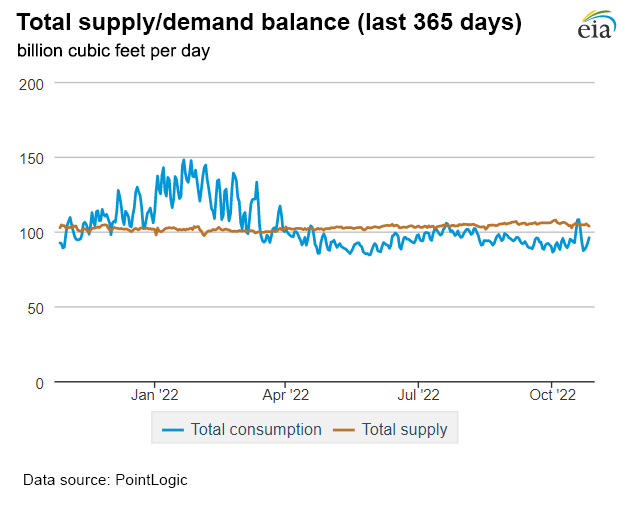
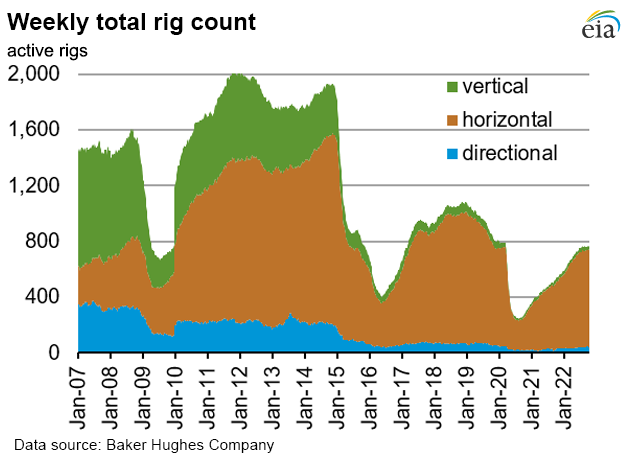
| Rigs | |||
|---|---|---|---|
Tue, October 18, 2022 |
Change from |
||
last week |
last year |
||
| Oil rigs | 612 |
0.3% |
38.1% |
| Natural gas rigs | 157 |
0.0% |
58.6% |
| Note: Excludes any miscellaneous rigs | |||
| Rig numbers by type | |||
|---|---|---|---|
Tue, October 18, 2022 |
Change from |
||
last week |
last year |
||
| Vertical | 22 |
-4.3% |
-21.4% |
| Horizontal | 708 |
0.4% |
46.9% |
| Directional | 41 |
0.0% |
28.1% |
| Data source: Baker Hughes Company | |||
| Working gas in underground storage | ||||
|---|---|---|---|---|
Stocks billion cubic feet (Bcf) |
||||
| Region | 2022-10-21 |
2022-10-14 |
change |
|
| East | 825 |
812 |
13 |
|
| Midwest | 1,007 |
987 |
20 |
|
| Mountain | 199 |
195 |
4 |
|
| Pacific | 248 |
249 |
-1 |
|
| South Central | 1,116 |
1,099 |
17 |
|
| Total | 3,394 |
3,342 |
52 |
|
| Data source: U.S. Energy Information Administration Form EIA-912, Weekly Underground Natural Gas Storage Report | ||||
| Working gas in underground storage | |||||
|---|---|---|---|---|---|
Historical comparisons |
|||||
Year ago (10/21/21) |
5-year average (2017-2021) |
||||
| Region | Stocks (Bcf) |
% change |
Stocks (Bcf) |
% change |
|
| East | 882 |
-6.5 |
893 |
-7.6 |
|
| Midwest | 1,048 |
-3.9 |
1,054 |
-4.5 |
|
| Mountain | 212 |
-6.1 |
214 |
-7.0 |
|
| Pacific | 255 |
-2.7 |
290 |
-14.5 |
|
| South Central | 1,139 |
-2.0 |
1,140 |
-2.1 |
|
| Total | 3,536 |
-4.0 |
3,591 |
-5.5 |
|
| Data source: U.S. Energy Information Administration Form EIA-912, Weekly Underground Natural Gas Storage Report | |||||
| Temperature – heating & cooling degree days (week ending Oct 20) | ||||||||
|---|---|---|---|---|---|---|---|---|
HDDs |
CDDs |
|||||||
| Region | Current total |
Deviation from normal |
Deviation from last year |
Current total |
Deviation from normal |
Deviation from last year |
||
| New England | 89 |
-16 |
41 |
0 |
0 |
-2 |
||
| Middle Atlantic | 101 |
8 |
61 |
0 |
-1 |
-7 |
||
| E N Central | 150 |
52 |
94 |
0 |
-1 |
-4 |
||
| W N Central | 158 |
61 |
82 |
0 |
-2 |
0 |
||
| South Atlantic | 73 |
21 |
43 |
18 |
-7 |
-17 |
||
| E S Central | 89 |
39 |
53 |
1 |
-9 |
-16 |
||
| W S Central | 39 |
20 |
19 |
24 |
-3 |
-9 |
||
| Mountain | 70 |
-23 |
-41 |
12 |
1 |
7 |
||
| Pacific | 12 |
-25 |
-40 |
13 |
6 |
12 |
||
| United States | 90 |
18 |
39 |
9 |
-2 |
-5 |
||
|
Data source: National Oceanic and Atmospheric Administration Note: HDDs=heating degree days; CDDs=cooling degree days | ||||||||
Average temperature (°F)
7-day mean ending Oct 20, 2022
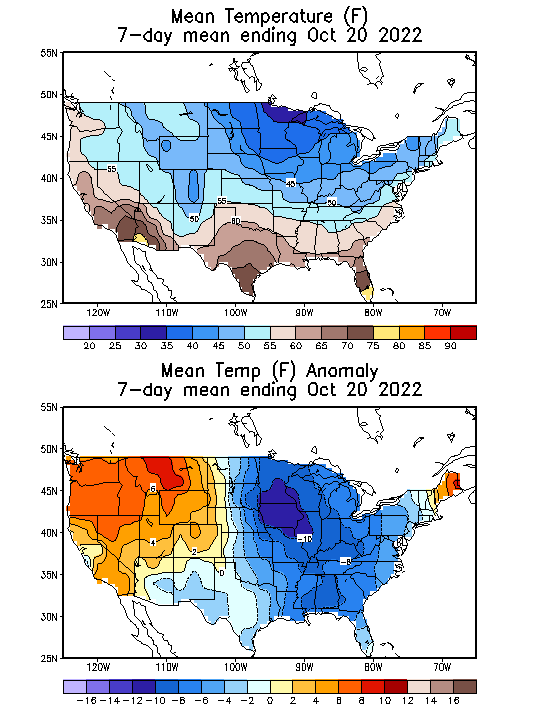
Data source: National Oceanic and Atmospheric Administration
Deviation between average and normal temperature (°F)
7-day mean ending Oct 20, 2022

Data source: National Oceanic and Atmospheric Administration

